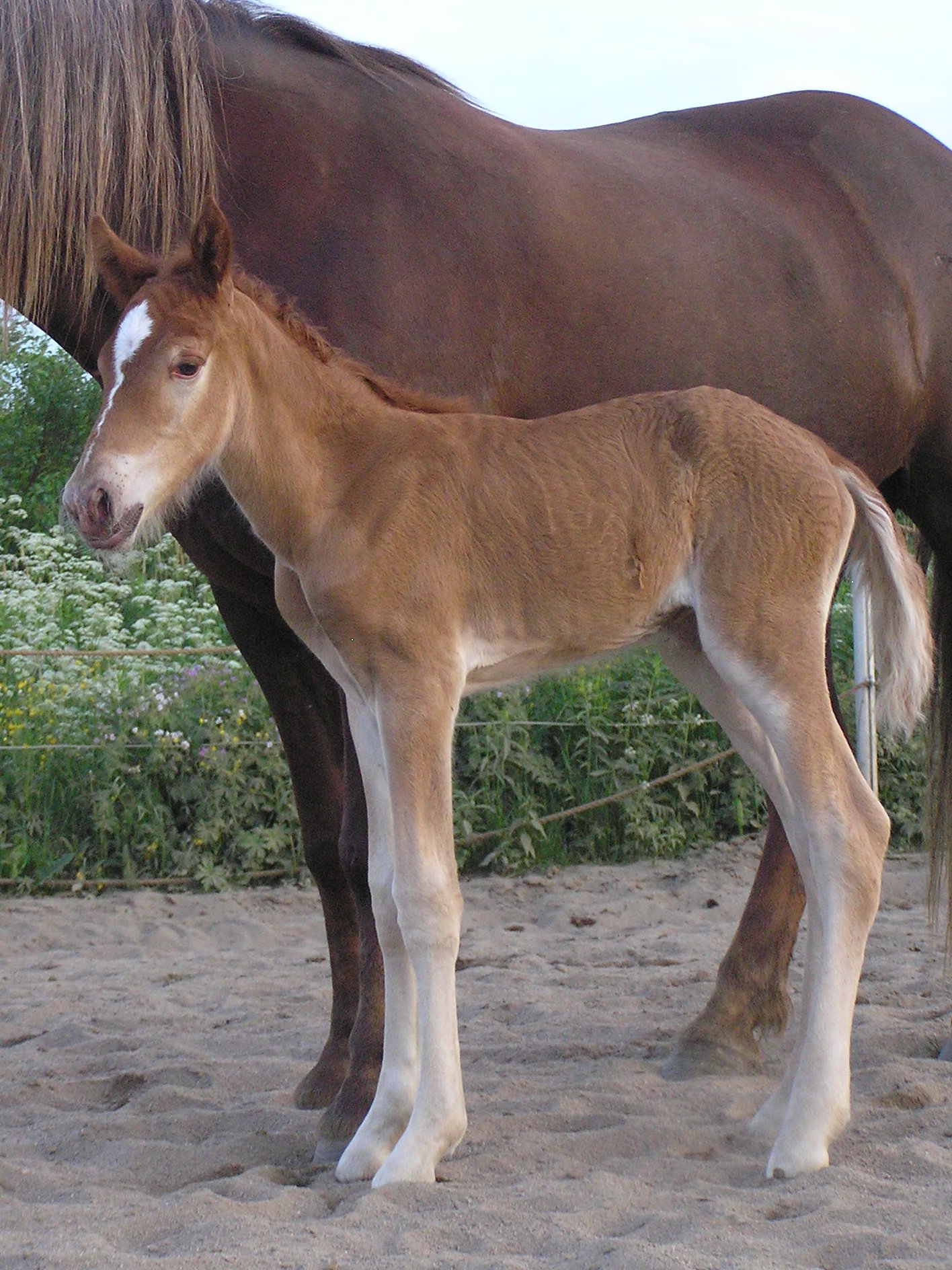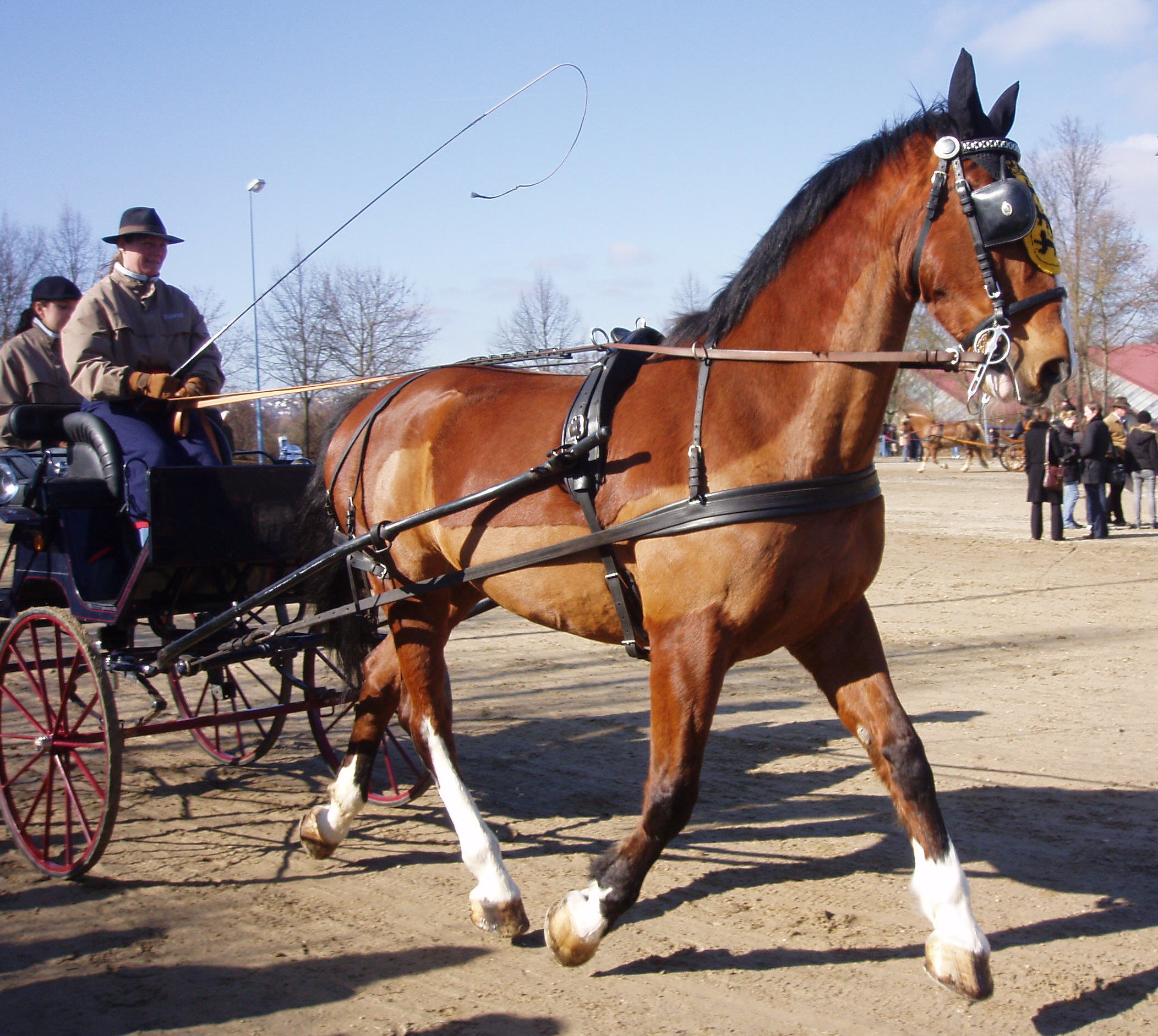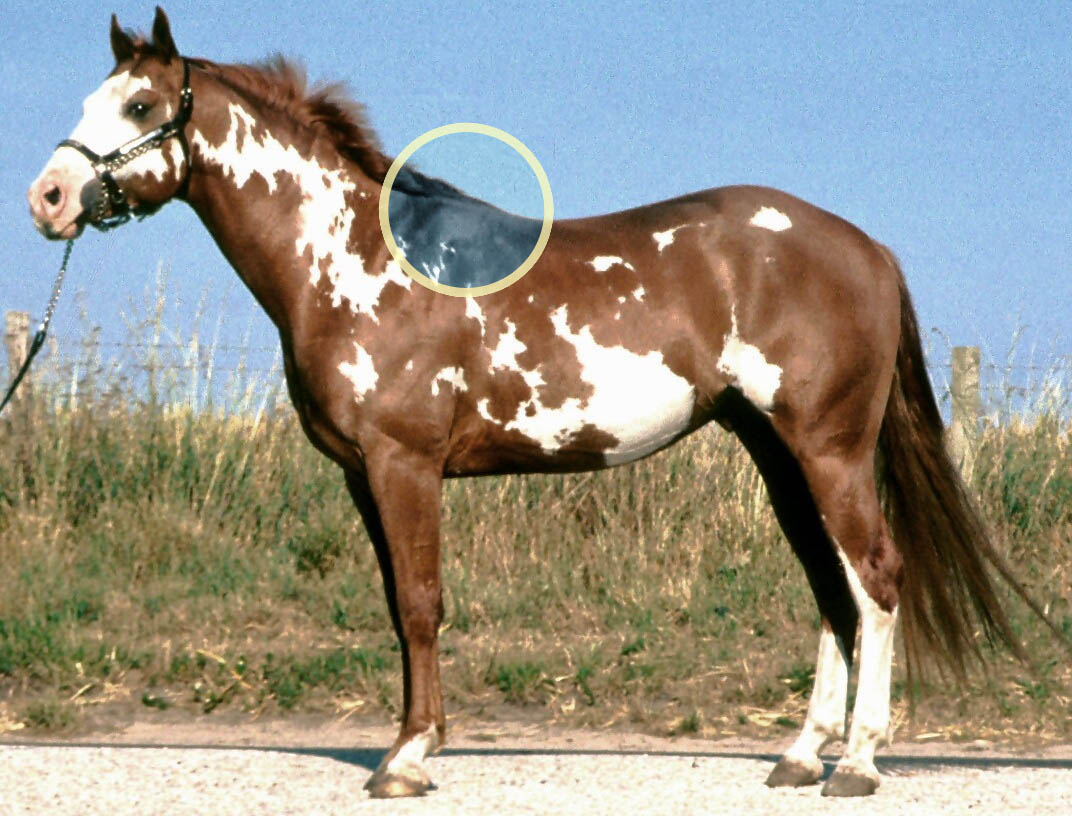|
Danish Warmblood
The Danish Warmblood or Dansk Varmblod is a Danish breed of modern sport horse, established in the mid-twentieth century and used mainly for dressage and show-jumping. Like other European warmblood breeds, it is a performance breed: any suitable horse of any origin may be admitted if it passes a strict performance test. Hanoverian, Holsteiner, Swedish Warmblood and Trakehner are among those that have contributed to the breed. History The Danish Warmblood came into existence in 1962 with the formation of a breed society, the ; in 1979 this merged with another association, the , to form the present association, Dansk Varmblod. The first volume of the stud-book was published in 1964, and listed 150 mares. Most were imported from outside Denmark – more than 100 were of German breeding – and of the 22 born in Denmark the majority were of Oldenburger origin. Characteristics The horses usually stand some at the withers. The coat may be of any solid colour; bay is the mos ... [...More Info...] [...Related Items...] OR: [Wikipedia] [Google] [Baidu] |
DAD-IS
DAD-IS is the acronym of the worldwide Domestic Animal Diversity Information System of the Food and Agriculture Organization of the United Nations, within the FAO's management of animal genetic resources programme.Domestic Animal Diversity Information System (DADIS)- About. Food and Agriculture Organization of the United Nations. It includes a searchable database of information about breeds, the Global Databank for Animal Genetic Resources; it also holds tools for management, and contacts for the National and Regional Coordinators for the programme. Data frothe Global Databankis used for reporting on the global status and trends of animal genetic resources. The fourth version of the DAD-IS was launched on 21 November 2017. Breeds in the Global Databank There were 11,116 mammalian national breed populations in DAD-IS as of February 2016, and 3,799 avian national breed populations.2016. FAO. Status of Animal Genetic Resources. http://www.fao.org/documents/card/en/c/c40d538b-47 ... [...More Info...] [...Related Items...] OR: [Wikipedia] [Google] [Baidu] |
Oldenburger
The Oldenburg or Oldenburger is a warmblood horse from the north-western corner of Lower Saxony, what was formerly the Grand Duchy of Oldenburg. The breed was built on a mare base of all-purpose farm and carriage horses, today called the Alt-Oldenburger. The modern Oldenburg is managed by the Association of Breeders of the Oldenburger Horse, which enacts strict selection of breeding stock to ensure that each generation is better than the last. Oldenburgers are tall sport horses with excellent gaits and jumping ability. The breeding of Oldenburg horses is characterized by very liberal pedigree requirements and the exclusive use of privately owned stallions rather than restriction to a state-owned stud farm. History Until the 17th century, horses in the region of Oldenburg were likely small and plain, but strong enough to be used to work the heavy soil of the Frisian coast. These horses would become the foundation of the Oldenburg's neighbors from Holstein to Groningen. One ... [...More Info...] [...Related Items...] OR: [Wikipedia] [Google] [Baidu] |
Horse Breeds
This article is a list of horse and pony breeds with articles on Wikipedia, and also includes terms for types of horse that are not necessarily standardized breeds but are often labeled as breeds. While there is no scientifically accepted definition of the term "breed",The state of the world's animal genetic resources for food and agriculture. Barbara Rischkowsky and Dafydd Pilling. Commission on Genetic Resources for Food and Agriculture. 2007 a breed is generally defined as having distinct true-breeding characteristics over a number of generations. Its members may be called "purebred". In most cases, bloodlines of horse breeds are recorded with a breed registry. The concept is somewhat flexible in horses, as open stud books are created for recording pedigrees of horse breeds that are not yet fully true-breeding. Registries also are considered the authority as to whether a given breed is listed as a "horse" or a "pony". There are also a number of " color breed", sport hor ... [...More Info...] [...Related Items...] OR: [Wikipedia] [Google] [Baidu] |
Vilhelmsborg
Vilhelmsborg is the National Equestrian Centre of Denmark and a listed building in Aarhus Municipality. The main manor building was completed in 1842 and was listed by the Danish Heritage Agency on 3 March 1945. The manor lies 10 km. south of Aarhus, by Beder-Malling in Mårslet Parish, and is today owned by Aarhus Municipality along with 288 hectares of adjoining land. In the 19th century H. C. Andersen lived on the Vilhelmsborg estate on several occasions and some of his fairy tales are said to have been inspired by the view of Mols from his window. Johan Skjoldborg also frequented the estate and his novel ''Gyldholm'' depicts the hardships of farm hands by the end of the 19th century. History The Vilhelmsborg estate lies on the site of the former farm ''Skumstrupgård'' and the small village of ''Skumstrup''. The farm was elevated to the status of manor at the end of the 15th century and over time it gradually absorbed the lands and farms surrounding it until the vill ... [...More Info...] [...Related Items...] OR: [Wikipedia] [Google] [Baidu] |
White Markings
Markings on horses are usually distinctive white areas on an otherwise dark base coat color. Most horses have some markings, and they help to identify the horse as a unique individual. Markings are present at birth and do not change over the course of the horse's life. Most markings have pink skin underneath most of the white hairs, though a few faint markings may occasionally have white hair with no underlying pink skin. Markings may appear to change slightly when a horse grows or sheds its winter coat, however this difference is simply a factor of hair coat length; the underlying pattern does not change. On a gray horse, markings visible at birth may become hidden as the horse turns white with age, but markings can still be determined by trimming the horse's hair closely, then wetting down the coat to see where there is pink skin and black skin under the hair. Recent studies have examined the genetics behind white markings and have located certain genetic loci that influence ... [...More Info...] [...Related Items...] OR: [Wikipedia] [Google] [Baidu] |
Dark Bay
Bay is a hair coat color of horses, characterized by a reddish-brown or brown body color with a black point coloration on the mane, tail, ear edges, and lower legs. Bay is one of the most common coat colors in many horse breeds. The black areas of a bay horse's hair coat are called "black points", and without them, a horse is not a bay horse. Black points may sometimes be covered by white markings; however such markings do not alter a horse's classification as "bay". Bay horses have dark skin – except under white markings, where the skin is pink. Genetically, bay occurs when a horse carries both the Agouti gene and a black base coat. While the basic genetics that create bay coloring are fairly simple, the genes themselves and the mechanisms that cause shade variations within the bay family are quite complex and, at times, disputed. The genetics of dark shades of bay are still under study. The genetic mechanism that produces seal brown has yet to be isolated. Sooty geneti ... [...More Info...] [...Related Items...] OR: [Wikipedia] [Google] [Baidu] |
Grey (horse)
A gray horse (or grey horse) has a coat color characterized by progressive depigmentation of the colored hairs of the coat. Most gray horses have black skin and dark eyes; unlike some equine dilution genes and some other genes that lead to depigmentation, gray does not affect skin or eye color. Gray horses may be born any base color, depending on other color genes present. White hairs begin to appear at or shortly after birth and become progressively more prevalent as the horse ages as white hairs become intermingled with hairs of other colors. Graying can occur at different rates—very quickly on one horse and very slowly on another. As adults, most gray horses eventually become completely white, though some retain intermixed light and dark hairs. The stages of graying vary widely. Some horses develop a dappled pattern for a period of time, others resemble a roan with more uniform intermixing of light and dark hairs. As they age, some gray horses, particularly those heteroz ... [...More Info...] [...Related Items...] OR: [Wikipedia] [Google] [Baidu] |
Chestnut (coat Colour)
Chestnut is a hair coat color of horses consisting of a reddish-to-brown coat with a mane and tail the same or lighter in color than the coat. Chestnut is characterized by the absolute absence of true black hairs. It is one of the most common horse coat colors, seen in almost every breed of horse. Chestnut is a very common coat color but the wide range of shades can cause confusion. The lightest chestnuts may be mistaken for palominos, while the darkest shades can be so dark they appear black. Chestnuts have dark brown eyes and black skin, and typically are some shade of red or reddish brown. The mane, tail, and legs may be lighter or darker than the body coat, but unlike the bay they are never truly black. Like any other color of horse, chestnuts may have pink skin with white hair where there are white markings, and if such white markings include one or both eyes, the eyes may be blue. Chestnut foals may be born with pinkish skin, which darkens shortly afterwards. Chestnut i ... [...More Info...] [...Related Items...] OR: [Wikipedia] [Google] [Baidu] |
Bay (horse)
Bay is a hair coat color of horses, characterized by a reddish-brown or brown body color with a black point coloration on the mane, tail, ear edges, and lower legs. Bay is one of the most common coat colors in many horse breeds. The black areas of a bay horse's hair coat are called "black points", and without them, a horse is not a bay horse. Black points may sometimes be covered by white markings; however such markings do not alter a horse's classification as "bay". Bay horses have dark skin – except under white markings, where the skin is pink. Genetically, bay occurs when a horse carries both the Agouti gene and a black base coat. While the basic genetics that create bay coloring are fairly simple, the genes themselves and the mechanisms that cause shade variations within the bay family are quite complex and, at times, disputed. The genetics of dark shades of bay are still under study. The genetic mechanism that produces seal brown has yet to be isolated. Sooty ... [...More Info...] [...Related Items...] OR: [Wikipedia] [Google] [Baidu] |
Withers
The withers is the ridge between the shoulder blades of an animal, typically a quadruped. In many species, it is the tallest point of the body. In horses and dogs, it is the standard place to measure the animal's height. In contrast, cattle are often measured to the top of the hips. The term (pronounced ) derives from Old English ''wither'' (“against”), because it is the part of a draft animal that pushes against a load. Horses The withers in horse The horse (''Equus ferus caballus'') is a domesticated, one-toed, hoofed mammal. It belongs to the taxonomic family Equidae and is one of two extant subspecies of ''Equus ferus''. The horse has evolved over the past 45 to 55 million ...s are formed by the dorsal spinal processes of roughly the 3rd through 11th thoracic vertebrae, which are unusually long in this area. Most horses have 18 thoracic vertebrae. The processes at the withers can be more than long. Since they do not move relative to the ground a ... [...More Info...] [...Related Items...] OR: [Wikipedia] [Google] [Baidu] |
Stud-book
A breed registry, also known as a herdbook, studbook or register, in animal husbandry and the hobby of animal fancy, is an official list of animals within a specific breed whose parents are known. Animals are usually registered by their breeders while they are young. The terms studbook and register are also used to refer to lists of male animals "standing at stud", that is, those animals actively breeding, as opposed to every known specimen of that breed. Such registries usually issue certificates for each recorded animal, called a pedigree, pedigreed animal documentation, or most commonly, an animal's "papers". Registration papers may consist of a simple certificate or a listing of ancestors in the animal's background, sometimes with a chart showing the lineage. Types of registries There are breed registries and breed clubs for several species of animal, such as dogs, horses, cows and cats. The US ''Association of Zoos and Aquariums'' (AZA) also maintains stud books for capt ... [...More Info...] [...Related Items...] OR: [Wikipedia] [Google] [Baidu] |
WPT2013-CDI4-Sayn-Wittgenstein,Nathalie Zu-Fabienne-2
WPT may refer to: * World Poker Tour The World Poker Tour (WPT) is an internationally televised gaming and entertainment brand. Since 2002, the World Poker Tour has operated a series of international poker tournaments and associated television series broadcasting playdown and the fi ... * Wireless power transfer * Wisconsin Public Television, the former brand name of PBS Wisconsin {{disambiguation ... [...More Info...] [...Related Items...] OR: [Wikipedia] [Google] [Baidu] |



.jpg)


